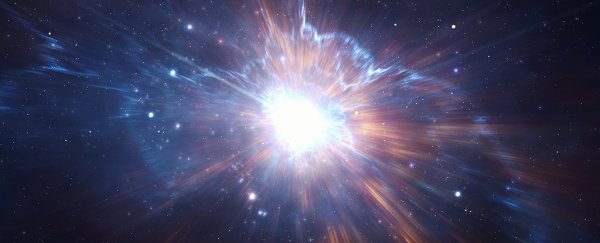Astronomers have come up with the most precise measurement of the Universe's expansion rate so far - and sure enough, it still appears to be accelerating.
The increasing speed shouldn't come as a shock – we've suspected it for a while. What this measurement does is reduce the odds that it's a coincidence to 1 in 5,000, meaning we're really going to need some clever new ideas to explain it.
After six years of measurements based on a rather clever use of NASA's Hubble telescope, astronomers have calculated the rate of our Universe's stretch with only 2.3 percent uncertainty.
We know space is expanding. The push behind this swelling of space, whatever it might be, is quantified by a number – the Hubble Constant, given in kilometres per second per megaparsec.
As you might expect, the tools we use to arrive at this figure produce slightly different answers. Most tend to say the Universe is expanding a touch over 70 km/s/Mpc (around 44 miles/s/Mpc).
But one tool comes up with a significantly different result. By analysing the cosmic microwave background – the echo of light still rippling through space 13.8 billion years ago – the Planck Mission has come up with a figure closer to 67.8 km/s/Mpc (about 42 miles/s/Mpc).
That doesn't seem like much of a difference, but it's enough to give astronomers pause.
"The community is really grappling with understanding the meaning of this discrepancy," says this latest study's lead researcher Adam Riess from the Space Telescope Science Institute (STScI) and Johns Hopkins University.
The conclusion by Nobel Laureate Brian Schmidt and Nicholas B. Suntzeff in the 1990s was that the expansion of the Universe isn't winding down, but winding up.
And results like those from Hubble and Planck only confirm the Universe was probably expanding slower in the distant past.
Still, physicists and astronomers don't like to gamble on 'probably'. So they look for even more ways to refine those numbers in the hope they either come together or reveal something we've missed.
Riess's team used Hubble to gather data on objects called Cepheid variable stars.
Much like the light from supernovae, Cepheid starlight is assumed to be reliable enough to make for a solid galactic yardstick – we can be sure that fainter stars are farther away, and not just less luminous.
The researchers behind the study first studied Cepheid stars in our own galaxy to refine correlations of apparent brightness and distance.
Existing data was based on just a handful of Cepheids between 300 and 1,600 light-years from Earth.
This team figured they could do better, so they came up with a way to push the Hubble telescope to its limits and gather information on Cepheids 6,000 to 12,000 light-years away.
To gauge their exact distance, they looked at the change in their positions as Earth moved around the Sun. To give you some idea of what that parallax shift looked like, imagine trying to determine a distance as wide as a grain of sand around 150 kilometres (about 100 miles) away.
They accomplished this insane feat by measuring each star's position a thousand times a minute every six months for four years.
"You're measuring the separation between two stars, not just in one place on the camera, but over and over thousands of times, reducing the errors in measurement," says Riess.
Armed with better data on Cepheid stars, they searched for them in distant galaxies and came up with a figure closer to 73.45 ± 1.66 km/s/Mpc (45.64 ± 1.03 miles/s/Mpc), decreasing the uncertainty in the number to a record 2.3 percent.
Riess now plans on collecting data on another 50 Cepheid stars and pushing that precision up even further.
That makes it even less likely that the difference in measurements over Universe's lifetime is coincidental. Something is going on.
Is it a mysterious force called dark energy? Evidence of a need to change our minds about the shape of the Universe? A mysterious form of physics called dark radiation?
Place your bets now, folks. Because physics is about to get weird.
A version of this article was first published in February 2018. The research is now published in The Astrophysical Journal.
